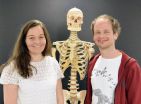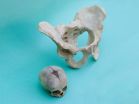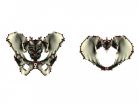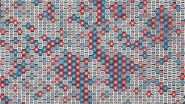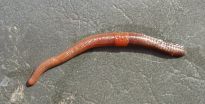Large heads, narrow pelvises and difficult childbirth in humans
New study identifies a complex link between pelvis, head and stature that evolved to ease childbirth
2015-04-22
(Press-News.org) This news release is available in German.
The size of the neonatal skull is large relative to the dimensions of the birth canal in the female pelvis. This is the reason why childbirth is slower and more difficult in humans than in most other primates. Scientists from the Universities of Oslo and Vienna, identified adaptations in the morphology of the human body, which were unknown so far. The results of this new study appeared in the current edition of PNAS.
Upright walking and difficult birth
In hominids, upright walking evolved 4-5 million years ago. The human pelvis was affected by these changes and evolved accordingly to better serve the new pattern of movement. Later, after bipedal movement had long become obligatory, brains evolved to increasingly larger volumes. With that change, the head size of neonates also increased. The growing heads, however, had to be delivered through pelvises that were earlier adapted to upright walking. This is the reason for the lack of space in the modern human birth canal during childbirth, which we have to live with today. The evolution of these patterns remains to have severe consequences. Women in developing countries, who do not have access to modern medical care or cesarean sections during birth, still suffer from high mortality due to childbirth.
Analysis of 3D data
Barbara Fischer, an evolutionary biologist at the Universities of Oslo and Vienna, had the idea to study the consequences of this persistent strong selection pressure due to childbirth on human morphology. Together with Philipp Mitteroecker, an anthropologist at the University of Vienna, she analyzed 3D data of the human pelvis to study these questions. The data that they used in their analysis had originally been collected for a very different purpose. "The motivation for the US-American researchers who collected these pelvis data in the 1980s was an industrial one. They wanted to improve the design of crash test devices and car seats to increase vehicle safety", explains Fischer. A large number of human pelvises were measured in detail for this reason.
With these data, Fischer and Mitteroecker discovered a complex association between the shape of the pelvis, body height and head size, within the human body. This association helps to ease the obstetric dilemma. Their results show that the dimensions of head and height do not vary independently, but instead they are linked to pelvis shape.
Head and stature
The size of the human head is to a large extent genetically determined. This is why women with large heads tend to give birth to neonates with large heads. "We found out that women with large heads, compared to women with small heads, possess a birth canal that is shaped in a way that neonates with large heads can pass it easier", explains Barbara Fischer: The sacrum is shorter in these women and it leaves more space in the outlet of the birth canal, which is beneficial for birth.
It is well known from the gynecological literature that short women, compared to taller women, on average have harder births and carry a higher risk that the fetus will not fit through the birth canal at birth. Fischer and Mitteroecker show in their study that shorter women possess a rounder birth canal, which is likely an adaptation to the stronger selection pressure at birth in these women. Despite the identified patterns, the authors clarify that the individual risk for a difficult birth depends on various environmental influences along with genetic factors.
INFORMATION:
Publication in PNAS
Covariation between human pelvis shape, stature, and head size alleviates the obstetric dilemma
Fischer B., Mitteroecker P. 2015
PNAS, April 20, 2015, doi:10.1073/pnas.1420325112
ELSE PRESS RELEASES FROM THIS DATE:
2015-04-22
Is it possible to prevent mental health problems in higher education students? The answer is "yes" according to a team of psychologists from Loyola University Chicago who conducted a careful, systematic review of 103 universal interventions involving over 10,000 students enrolled in 2- and 4-year colleges and universities and graduate programs. The findings appear in the May 2015 issue of Prevention Science, published by Springer.
Researchers indicated that universal prevention interventions - that is, programs targeting general students, not just students who are at ...
2015-04-22
Researchers from Plymouth University Peninsula Schools of Medicine and Dentistry are part of a team led by the University of Oxford, who have carried out new research that suggests mindfulness-based cognitive therapy (MBCT) could provide an alternative non-drug treatment for people who do not wish to continue long-term antidepressant treatment.
The results are published in "The Lancet".
The results come from the first ever large study to compare MBCT - structured training for the mind and body which aims to change the way people think and feel about their experiences ...
2015-04-22
Fragments of asteroids regularly land on Earth as meteorites. If you examine such a find, you can see that it comprises millimetre-sized round stones, known as chondrules. These small particles are believed to be the original building blocks of the solar system. However, the research community has not previously been able to explain how the chondrules formed asteroids. A new study shows that asteroids were formed by capturing chondrules with the help of gravitational force.
"The chondrules are of exactly the right size to be slowed down by the gas that orbited the young ...
2015-04-22
Researchers at the Institut Hospital del Mar d'Investigacions Mèdiques (IMIM) have identified a new way of treating colorectal cancer. In the study published in the journal Science Signaling, the team led by LLuís Espinosa, investigator of IMIM's research group into stem cells and cancer, have shown that inhibition of endosomal activity is a potential therapeutic strategy for the treatment of cancers with the BRAF mutated gene. This discovery is an important step in the personalisation of the treatment of colorectal cancer, as the presence of this mutation is ...
2015-04-22
Bethesda, MD (April 22, 2015) -- The May issues of AGA's journals -- Clinical Gastroenterology and Hepatology and Gastroenterology -- highlight important research updates on the most deadly forms of liver disease. Here's what you need to know:
Researchers confirm that NAFLD worsens heart disease.
One specific cardiovascular disease risk factor -- psychological distress -- is linked to death from liver disease in a large, general population sample.
Improvements in cirrhosis care have contributed to a 41 percent decrease in inpatient mortality.
For access to any of ...
2015-04-22
Researchers from North Carolina State University have discovered that electron spin brings a previously unknown degree of order to the high entropy alloy nickel iron chromium cobalt (NiFeCrCo) - and may play a role in giving the alloy its desirable properties.
"High entropy alloys have garnered a lot of attention over the past 10 years because they have remarkable properties," says Doug Irving, an associate professor of materials science and engineering at NC State and corresponding author of a paper describing the work. High entropy alloys are materials that consist ...
2015-04-22
COLUMBUS, Ohio--An international research team is bringing a new weapon to bear against invasive earthworms.
The ongoing research project at The Ohio State University, the University of Alberta and Simon Fraser University uses statistical analysis to forecast one worm species' spread, in hopes of finding ways to curtail it.
Most recently, they've focused on the boreal forest of northern Alberta. No native worms live in the forest whatsoever; the region had been worm-free since the last ice age 11,000 years ago, until invasive European species began working their way ...
2015-04-22
Alternative variations from popular artists' videos may reach an audience of millions, shows the new study from Finland's Aalto University.
Music is the most popular YouTube content by several measures, including video views and search activity. The world's first academic study on YouTube music consumption by Aalto University in Finland shows that one reason for its popularity lies in users' own video. People re-use original music by popular artists to create their own alternative video variations, which may reach an audience of millions and can be found alongside any ...
2015-04-22
TORONTO, April 22, 2015--In a study to ascertain whether breast arterial calcification (BAC) detected with digital mammography correlates to chest CT findings of coronary artery calcification (CAC), researchers have discovered a striking relationship between the two factors. In 76% of the study cohort, women who had a BAC score of 0 also had a CAC score of 0. As the BAC score increases, there is a concomitant increase in the CAC score.
The findings indicate that the presence of BAC could play a significant role in identifying women who may benefit from coronary artery ...
2015-04-22
The exoplanet 51 Pegasi b [1] lies some 50 light-years from Earth in the constellation of Pegasus. It was discovered in 1995 and will forever be remembered as the first confirmed exoplanet to be found orbiting an ordinary star like the Sun [2]. It is also regarded as the archetypal hot Jupiter -- a class of planets now known to be relatively commonplace, which are similar in size and mass to Jupiter, but orbit much closer to their parent stars.
Since that landmark discovery, more than 1900 exoplanets in 1200 planetary systems have been confirmed, but, in the year of the ...
LAST 30 PRESS RELEASES:
[Press-News.org] Large heads, narrow pelvises and difficult childbirth in humans
New study identifies a complex link between pelvis, head and stature that evolved to ease childbirth
